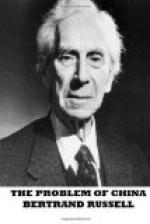[Footnote 70: Millard, p. 99.]
[Footnote 71: See Pooley, Japan’s Foreign Policies, pp. 23 ff; Coleman, The Far East Unveiled, chap, v., and Millard, chap. iii.]
[Footnote 72: Millard, pp. 64-66.]
[Footnote 73: Reid, op. cit. pp. 114-5; Cheng, op. cit., pp. 343-6.]
[Footnote 74: See Appendix III of Cheng’s Modern China, which contains this note (p. 346) as well as the other “documents relative to the negotiations between Japan and the Allied Powers as to the disposal of the German rights in respect of Shantung Province, and the South Sea Islands north of the Equator.”]
[Footnote 75: The story of the steps leading up to China’s declaration of war is admirably told in Reid, op. cit. pp. 88-109.]
[Footnote 76: Port of the letter is quoted by Dr. Reid, p. 108.]
[Footnote 77: Reid, op. cit. p. 161. Chap. vii. of this book, “Commercial Rivalries as affecting China,” should be read by anyone who still thinks that the Allies stood for honesty or mercy or anything except money-grubbing.]
[Footnote 78: Appendix C, pp. 421-4.]
[Footnote 79: A list of these loans is given by Hollington K. Tong in an article on “China’s Finances in 1918” in China in 1918, published early in 1919 by the Peking leader, pp. 61-2. The list and some of the comments appear also in Putnam Weale’s The Truth about China and Japan.]
[Footnote 80: Mr. Lansing’s book, in so far as it deals with Japanese questions, is severely criticized from a Japanese point of view in Dr. Y. Soyeda’s pamphlet “Shantung Question and Japanese Case,” League of Nations Association of Japan, June 1921. I do not think Dr. Soyeda’s arguments are likely to appeal to anyone who is not Japanese.]
[Footnote 81: See the clauses concerning Shantung, in full, in Cheng’s Modern China, Clarendon Press, pp. 360-1.]
[Footnote 82: This agitation is well described in Mr. M.T.Z. Tyau’s China Awakened (Macmillan, 1922) chap, ix., “The Student Movement.”]
[Footnote 83: “Soviet Russia has addressed to the Powers a protest against the discussion at the Washington Conference of the East China Railway, a question exclusively affecting China and Russia, and declares that it reserves for itself full liberty of action in order to compel due deference to the rights of the Russian labouring masses and to make demands consistent with those rights” (Daily Herald, December 22, 1921). This is the new-style imperialism. It was not the “Russian labouring masses,” but the Chinese coolies, who built the railway. What Russia contributed was capital, but one is surprised to find the Bolsheviks considering that this confers rights upon themselves as heirs of the capitalists.]
CHAPTER IX
THE WASHINGTON CONFERENCE
The Washington Conference, and the simultaneous conference, at Washington, between the Chinese and Japanese, have somewhat modified the Far Eastern situation. The general aspects of the new situation will be dealt with in the next chapter; for the present it is the actual decisions arrived at in Washington that concern us, as well as their effect upon the Japanese position in Siberia.




